Using a cable machine for back exercises can provide you with some amazing gains in constructing a stronger, thicker, and wider back. Performing back exercises with cable machines may help to spice up your other larger compound lifts comparable to deadlifts or the overhead press.
Through the use of different attachments, angles, and weights, the cable machine can goal all the main and smaller muscles of your back. Cable exercises for the back enable you to maneuver your arms freely, thus reducing possible stress in your joints. Plus, they supply constant tension in your muscles, which is something that dumbbells can’t do.
We’re about to go over the 21 best cable machine back exercises to construct a back that you simply can be pleased with. We even have a cable machine only back workout…What I’m attempting to say is that we got your back with this one!
Table of Contents:
- What Is A Cable Machine?
- Are Cable Machine Back Exercises Good For Constructing Muscle?
- 21 Best Back Cable Exercises
- Advantages of Doing Cable Exercises For Back
- Back Muscle Anatomy
- Sample Back Cable Workouts
What’s a cable machine?
Invented by Jack LaLanne, some of the distinguished names in fitness history; the cable machine was then improved upon by Harold Zinkin within the 1950’s with the creation of the Universal Gym Equipment, a house workout machine that notably featured the cable or pulley system.
The cable machine or sometimes called the pulley machine is made from a steel frame that has stacks of weight plates which are attached to a cable system. Cable machines may be in single stacks like a lat pulldown machine or double stacks that allow for exercises where the user can grab one pulley with each hand.
You’ll be able to attach various pieces to the cables including pull up bars, stirrups(handle) V bars, ropes, straps and more. The cable may be adjusted at various height levels. You just select the quantity of weight, normally in increments of 5-10 kilos, select attachment then adjust the peak of the cable. Cable machines enable each advanced lifters and complete novices many advantages.
Now that you realize just a little more about this amazing piece of kit, you may consider buying one if you might have a house gym. That is why we analyzed and selected the Best Cable Machines available on the market today.
Are Cable Machines Good For Back Strengthening Exercises?
Yes, cable exercises for the back are great to construct muscle and strength. The cables promote smooth movement when executing quite a lot of cable back exercises with multiple combos of angles, weights, attachments, and body positions.
Walk into any gym and you will notice each the largest guys and girls using the cable machine for back exercises in addition to newcomers who aren’t so aware of the world of weightlifting. It’s because cable back exercises are super versatile, offering something for everybody.
Perhaps the primary reason why cable back exercises are so great is that they supply continuous tension much like resistance bands. One in all the important thing components of constructing muscle is time under tension. Using cable machines means there’s tension being applied to your muscles on each the eccentric and concentric portions of every exercise.
21 Best Cable Exercises to Construct Strength & Mass
We put together 21 of the perfect cable back exercises that can hit all the main muscles in your back. Let’s jump into them immediately!
1. Cable Lat Pulldown:

One of the crucial common cable back exercises, the lat pulldown is a incredible exercise so as to add strength and construct muscle mass to your lats. This movement won’t be as effective as a pullups when it comes to constructing muscle but you may easily change the load and grip placement so you may isolate certain areas of the back higher.
The lat pulldown is an excellent exercise since it puts constant tension in your muscles. It also makes the list for being top-of-the-line women’s back exercises. Searching for more great pulldown options? Take a look at these lat pulldown variations and these lat pulldown alternatives!
do the Cable Lat Pulldown:
- Attach lat pulldown bar then sit on the bench with the thigh pad over your knees
- Grab bar with each arms prolonged overhead using an overhand grip barely wider than shoulder width
- Keep your head back and chest up starting along with your arms completely stretched out
- Pull down until the bar reaches your chest while squeezing your shoulder blades together, hold at the underside briefly
- Slowly return to starting position
- Repeat for desired reps
Note: Pull bar with elbows, try to not rock much during movement. You too can use a large grip too. This may engage the lats to the next degree but the quantity of weight you’ll lift can be lower than medium or close grip pulldowns as your arm muscles aren’t activated as much.
Muscles Worked on Lat Pulldown: Lats, Rhomboids, Traps, Biceps, Rear Delts, Teres Major/Minor
2. Cable Incline Straight Arm Pulldowns:

The cable incline pushdown is an excellent movement to enhance scapular stability and strength, making it certainly one of my favorite back exercises with cables. The lats are heavily engaged on this exercise, nevertheless it also hits other muscles comparable to shoulders, pecs, and teres major.
That is a great exercise to do before deadlifts because it enforces proper scapular positioning, which is crucial for a correct deadlift form.
do the Cable Incline Straight Arm Pulldown:
- Arrange bench on incline of 45 degrees in front of pulley and fix a bar then set at a height above the incline bench
- Sit down along with your back against the bench facing away from the cable
- Grab the bar with each hands using an overhand grip, shoulder width apart
- Starting along with your arms straight above you where the bar is over your face
- Push down on the bar towards your knees keeping your elbows barely bent until your arms are parallel along with your thighs
- Slowly return to starting position while squeezing your lats together
- Repeat desired reps
Note: This exercise can be done with EZ bar attachment or rope. Be sure you may get full extension of the arms and don’t go too heavy where you jeopardize form.
Muscles Worked in Cable Incline Pushdown: Lats, Pec Major, Rear Delts, Teres Major
3. Cable Single-Arm Bent Over Row:

The one arm bent over row is perhaps even higher in your back than an everyday barbell row because that is unilateral where you may deal with the working muscles, one side at a time.
You’ll have the ability to spotlight muscle imbalances by doing this movement while also getting a greater range of motion. It is a difficult movement that can work your core and stabilizing muscles to execute properly.
do the Cable Single-Arm Bent Over Row:
- Set the set at ground level and fix a stirrup
- Step away from cable and get in a staggered stance grab the stirrup with hand on the identical side with the back leg. Place your inactive hand in your front knee
- Keeping your knees bent, lean forward so that you simply arm is stretched out
- Pull up and back through your elbow until your hand is near your ribcage
- Slowly return to starting position
- Repeat for desired reps
- Switch sides
Note: Keep your core engaged throughout the movement.
Muscles Worked During Single Arm Cable Row: Lats, Traps, Rear Delt, Teres Minor/Major, Biceps, Pec Major, Obliques, Hamstrings, Glutes
4. Cable Lying Pullover Extension:

This exercise is ideal for a deep stretch of the shoulders and lats which may expose any lack in range of motion. The cable pullover can assist to extend the back, chest and serratus anterior strength and size.
Arnold Schwarzenegger swore by this exercise, which should provide you with an idea of how effective it’s and why it’s on our list of best cable back exercises. You must deal with really letting your back and chest muscles do the work here with moderate to high rep range so which you could get an excellent stretch to stimulate growth while ensuring your form is on point.
Take a look at our article on the perfect Cable Pullover Variations for more great options!
do the Cable Lying Pullover Extension:
- Attach rope to cable and set it at level near the bottom and arrange a bench in front of the cable
- Lie down in your back along with your head towards the cable machine and grab the rope with a neutral grip
- Starting along with your arms stretched out back behind your head with elbows barely bent
- Pull rope straight over your head until your arms are straight above your chest
- Slowly return to starting position
- Repeat for desired reps
Note: This exercise can be done with a straight bar in the identical manner using an overhand grip. This variation will barely alter how the back muscles are targeted.
Muscle Worked in Cable Lying Pullover Extension: Lats, Triceps, Chest, Shoulders
5. Cable Neutral Grip Lat Pulldown:

This cable back exercise is ideal for constructing the width of the lats. The neutral grip lat pulldown promotes a full range of motion of the lats. Focus on squeezing your back muscles at the underside of the movement.
do the Cable Neutral Grip Lat Pulldown:
- Arrange the cable at chest level with handle attachments
- Kneel down in the middle facing the machines but barely behind the cables
- Reach up, grabbing each handles with a neutral grip
- Keeping your back straight and chest up pull your elbows down and back towards your sides until your hands are near your shoulders. Squeeze your shoulder blades together at the underside
- Slowly return to starting position
- Repeat for desired reps
Note: Squeeze your shoulder blades together and check out to to not rock an excessive amount of, deal with using your back muscles to drag the cables down.
Muscles Worked in Neutral Grip Pulldown: Lats, Rhomboids, Rear Delts, Biceps
6. Cable Lat Pulldown with V Bar:

This lat pulldown variation uses a neutral grip that permits a big selection of motion. You’ll be able to lift a heavier weight using this exercise compared with regular lat pulldowns.
You must have the ability to pack on some serious muscle with this cable back exercise. Take a look at these Close Grip Lat Pulldown Variations for more great variations.
do the Cable Lat Pulldown With V Bar:
- Setup V bar attachment then get into position on the seat along with your knees under the knee pads
- Reach as much as grab the V bar with each hands using a neutral grip
- Starting along with your arms fully prolonged, pull down keeping your chest up until your elbows are near your sides and your hands are only above your chest
- Slowly return to starting position
- Repeat for desired reps
Note: Be sure to maintain your back straight and chest up throughout the movement. You too can do that exercise from a kneeling/sitting position in case your gym doesn’t have a seated cable machine.
Muscles Worked in V Bar Cable Pulldown: Lats, Rhomboids, Shoulders, Biceps
7. Cable Rope Extension Incline Bench Row:

This variation of the row can assist to isolate the upper back. By lying face down on the bench, you won’t have the ability to cheat and use momentum to drag the cable back. Deal with pulling back through your elbows to reduce the engagement of your biceps.
do the Cable Rope Extension Incline Bench Row:
- Arrange a bench at 45 degrees facing the cable machine
- Attach a rope to the cable toward floor level
- Lie down face first on the bench and grab the rope with a neutral grip
- Starting along with your arms stretched out then slowly pull the rope towards your lower chest so far as possible
- Slowly return to starting position
- Repeat for desired reps
Note: Allow your arms to totally extend at first and be sure to contract your shoulder blades at the highest of the movement.
Muscles Worked in Cable Rope Incline Row: Lats, Rhomboids, Teres Major/Minor, Biceps
8. Bent Over Single-Arm Cable Pull:

An ideal exercise to develop unilateral strength while also getting a deep stretch. Your core can be challenged on this exercise because it is a unilateral back exercise where core engagement is important to maintain proper form.
do the Bent Over Single Arm Cable Pull:
- Arrange the stirrup at waist height
- Grab stirrup with an overhand grip then get right into a staggered stance
- Stand away from cable then hinge forward until your torso is parallel to the bottom along with your arm stretched forward
- Pull back through your elbow and rotate wrist until you find yourself with an underhand grip while staying near your side
- Hold briefly at the highest then slowly return to starting position
- Repeat for desired reps
- Switch sides
Note: Brace yourself along with your inactive arm and deal with only having your arm move throughout the movement.
Muscles Worked in Single Arm Cable Pull: Lats, Rhomboids, Teres Major, Pecs, Obliques, Biceps
9. Cable Squat Row:

This compound exercise is great for constructing muscle and burning calories, which is what we wish to see in our cable back exercises! It’s a mix of a squat and a row so that you’ll be working the biggest muscles in each your upper and lower body inside one exercise.
do the Cable Squat Row:
- Arrange cable with rope attachment just lower than hip height
- Get into squat position along with your arms fully prolonged grabbing the rope with a neutral grip
- Keeping your weight in your heels in a single motion rise up and pull the rope back until your hands reach your sides
- Slowly lower back into squat position while letting your arms straighten out
- Repeat for desired reps
Note: Keep your core engaged throughout movement, be sure you’re far enough from the machine so your arms may be fully prolonged. Select a weight that permits you to stay leaning back in your heels.
Muscles Worked in Cable Squat Row: Lats, Rhomboids, Quads, Glutes, Biceps
10. Cable Shrug:

The cable shrug is a wonderful exercise to focus on the trapezius muscle on the upper back. You’ll be able to isolate the traps to further activate the muscle, stimulating growth. Doing shrugs with a cable machine gives you the power to perform multiple variations with different body angles to differ the degree of contraction within the traps.
do the Cable Shrug:
- Attach a rope or bar to the cable towards ground level
- Grab the rope with a neutral grip and stand back until your traps are stretched
- Rise up straight while keeping your shoulders relaxed
- Shrug your shoulders up and back as high as possible, briefly hold and contract traps at the highest
- Slowly lower your arms back to starting position
- Repeat for desired reps
Note: For those who’re not in a position to squeeze at the highest, lower the load a bit so which you could get maximum contraction.
Muscles Worked in Cable Shrug: Traps, Forearms
11. Cable Crossover Lat Pulldown:

That is an excellent exercise that may really provide help to widen your upper back. The cable crossover lat pulldown is a back exercise that you mustn’t fixate on moving heavy weights. Really consider squeezing your shoulder blades together at the underside of the movement.
do the Cable Crossover Lat Pulldown:
- Arrange each side of the cable machine above head level and fix handles to each cables
- Grab each cable with an overhand grip with opposite arms by reaching across your body
- Get into position in the middle just behind the cables
- Start along with your arms above your head along with your wrists crossed over one another
- Pull down and back through the elbows while squeezing your shoulder blades together until your hands are near your shoulders along with your elbows at your sides
- Slowly return to starting position
- Repeat for desired reps
Note: For those who’re too tall you may do that exercise kneeling in the middle of the cables.
Muscles Worked in Cable Crossover Lat Pulldown: Lats, Rhomboids, Rear Delts, Teres Major/Minor, Biceps
12. Cable Single-Arm Row:

The seated single arm cable row is top-of-the-line cable back exercises since it is unilateral where you’ll work one side of your body at a time. Unilateral exercises like this can assist to pinpoint muscle imbalances after which correct them. This movement will even engage your core and stabilizing muscles which can assist prevent injuries in the long run.
do Seated Cable Rows:
- Sit on bench and adjust cable height to chest level and fix a handle
- Together with your back straight and your chest up grab the handle with a neutral grip along with your arm straight out in front of you
- Pull back towards you, keeping your elbow near your side until your hand is at your side
- Slowly return to starting position
- Repeat for desired reps
- Switch sides
Note: Try to maintain your back straight throughout the movement, you may place your inactive hand in your hip for extra stability.
Muscles Worked in Seated Cable Row: Lats, Traps, Rhomboids, Rear Delts, Biceps
13. Cable Twisting Standing Row:

This cable back exercise involves quite a few muscles because it requires you to barely rotate on the waist. Because this can be a unilateral exercise you’ll have to have interaction your core throughout the movement. Besides being an excellent back exercise, this movement also works your hips, glutes, and other lower body muscles.
do the Cable Twisting Standing Row:
- Attach a handle to the cable just under the chest then grab the handle with one hand using an overhand grip
- Step back and get right into a staggered stance, knees barely bent. Your arm must be out straight and your waist is rotated towards the cable.
- Keeping your elbow near your body, pull back towards your waist while rotating your waist to the identical direction
- Pause briefly at the highest of the movement then slowly return to starting position
- Repeat desired reps
- Switch sides
Note: Be sure the rotation is in your waist not hips. You’ll be able to place your inactive hand in your other hip for added stability.
Muscles Worked in Cable Twisting Standing Row: Lats, Teres Major/minor, Rhomboids, Rear Delts, Pec Major, Biceps, Obliques
14. Cable Pull Through:

That is an excellent exercise to strengthen the posterior chain, which may translate to raised deadlift performance. The muscles targeted in cable pull throughs are mainly accountable for propelling you forward so it’s essential that they function flawlessly.
do the Cable Pull Through:
- Arrange the rope attachment near the bottom
- Straddle the rope facing away from cable grabbing the rope with a neutral grip with palms facing one another
- Step forward so the rope is taut and your feet are shoulder width apart
- Barely bend your knees then hinge forward on the hips until your back is parallel with the bottom
- Keep your arms straight and rise up straight pulling the rope through your legs
- Hold briefly at the highest contracting your glutes then slowly lower back to starting position
- Repeat desired reps
Note: Don’t overextend your lower back at the highest of the movement, pull the rope using your lower back, glutes and hamstrings; not your arms.
Muscles Worked in Cable Pull Throughs: Erector Spinae, Gluteus Maximus, Hamstrings, Soleus
15. Cable Close Grip Row:
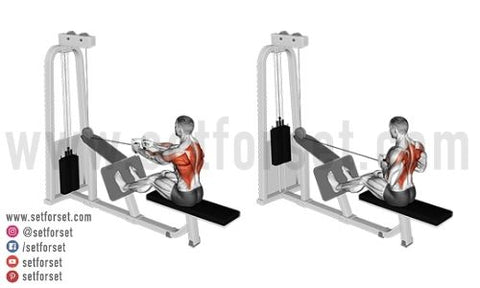
A variation of the seated row, the close grip row shifts the main focus to the mid back. With this exercise it is best to have the ability to lift heavier weight compared with the wide grip row because your lats are doing a lot of the work here. This exercise can pack on some serious muscle if done right.
do the Cable Close Grip Row:
- Attach a V bar to the cable then sit on the bench and place your feet on the foot rests
- Grab the bar with a neutral grip and ward off until your arms are stretched and your knees are barely bent
- Keeping your back straight and chest up along with your shoulders forward, pull back through your elbows until your hands are at your sternum
- Briefly hold at the highest then slowly return to starting position
- Repeat desired reps
Note: Don’t use your biceps to drag back and check out to limit any rocking motion.
Muscles Worked within the Cable Close Grip Row: Lats, Rhomboids, Traps, Teres Major/Minor, Rear Delts, Biceps
16. Cable Wide Grip Row:
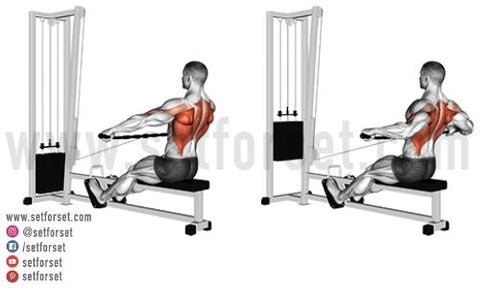
Wide grip rows could make your back thicker because nearly all of the work is completed by the muscles within the upper back. These upper back muscle will grow thicker fairly than wider. The important thing here is to not put an excessive amount of stress on the shoulders, as a substitute deal with using your back muscles to drag the load towards you.
do the Cable Wide Grip Row:
- Attach the wide grip bar to the cable
- Sit on the bench and grab the bar with each hands using an overhand grip along with your arms wider than shoulder width apart
- Beat back until your arms are straight along with your knees barely bent
- Lean back barely along with your back straight and your chest up then pull back through your elbows until the bar is just below your sternum
- Hold briefly at the highest then slowly return to starting position
- Repeat for desired reps
Note: Don’t rock forwards and backwards and begin with a lighter weight so you may deal with form. Keep your elbows out at 30 degrees, consider it such as you’re doing a bench press backwards.
Muscles Worked in Wide Grip Row: Lats, Teres Major/Minor, Rhomboids, Traps, Erector Spinae, Infraspinatus, Pecs
17. Cable Deadlift:
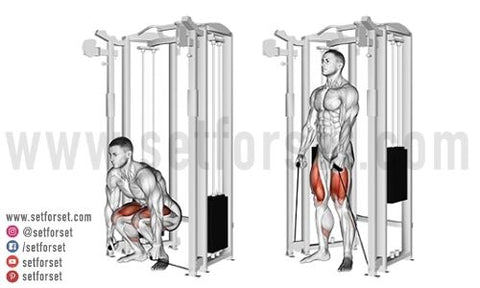
One in all my favorite cable back exercises, the cable deadlift mimics free weight deadlifts and is an excellent compound exercise to strengthen the lower back, glutes, and legs.
This exercise may be done as pictured below or with a single weight stack with a bar attachment. Deadlifts on the cable machine can provide help to to enhance your form as the load is equally constant throughout the movement.
do the Cable Deadlift:
- Arrange stirrups near ground level for those who’re using a dual cable machine or use a bar if using a single cable machine
- Stand facing away (facing) the cable machine
- Grab the stirrups or bar with an overhand grip
- Squat down into starting position along with your back straight
- Push into the bottom along with your feet bringing your body up, once your hands reach knee level bring your hips forward while straightening out your back until standing straight up
- Slowly lower to starting position in the identical manner
- Repeat desired reps
Note: Keep your core engaged throughout the movement.
Muscles Worked in Cable Deadlift: Hamstrings, Glutes, Erector Spinae, Traps
18. Cable Bent-Over Row with Bar:
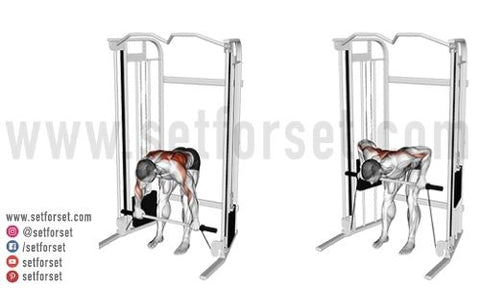
That is a tremendous compound exercise that works the back muscles and core muscles just like the rectus abdominis to maintain you stable and upright. You should use this same cable back exercise with different hand placements to focus on upper or lower back muscles. For those who switch to a large underhand grip you’ll emphasize your rear delts more.
do the Cable Bent Over Row With Bar:
- Arrange bar attachment near the bottom
- Stand behind bar and grab it with each hands just a little wider than shoulder width using an overhand grip
- Hinge on the hips and lean forward over the bar until your torso is parallel with the bottom
- Keeping your knees barely bent and your back straight pull up on the bar through your elbows until they’re parallel with the bottom
- Slowly lower to starting position
- Repeat for desired reps
Note: Attempt to not rock and use momentum to lift the bar. Keep your core engaged throughout the movement.
Muscles Worked in Cable Bent Over Row With Bar: Lats, Rhomboids, Teres Major/Minor, Trap, Rear Delts, Biceps, Infraspinatus, Glutes, Hamstrings
19. Kneeling Cable High Row:
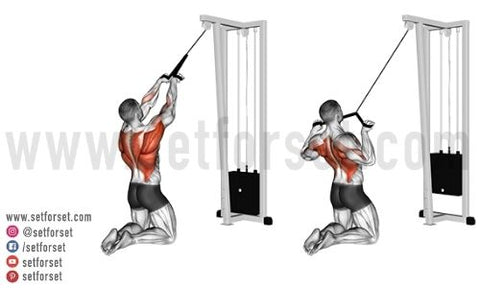
This high row variation offers a wider range of motion as a consequence of using the rope attachment. The kneeling cable high row also works the upper back muscles form a special angle with can assist support the expansion of a wider back.
do the Kneeling Cable High Row:
- Attach a rope to the cable and set at head level
- Kneel on the bottom a couple of feet back, facing the cable machine
- Start along with your arms fully prolonged up in front of you holding the rope with a neutral grip
- Pull through your elbows down and back and retract each shoulder blade until your elbows are at your sides
- Briefly pause then slowly return to starting position
- Repeat for desired reps
Note: Try to not lean too far back, as a substitute deal with pulling the rope along with your back muscles. The kneeling component makes it just a little easier to enhance your mind-body connection.
Muscles Worked in Kneeling Cable High Row: Lats, Rear Delts, Teres Major/Minor, Rhomboids, Biceps
20. Standing Cable Twist Row:

This back exercise includes some transverse plane motion as you can be twisting on the waist as you pull the load back. Working in multiple planes of motion is useful for every day life activities. All too often people are inclined to neglect the transverse plane so that is an excellent approach to boost your back workout a bit.
do the Standing Cable Twist Row:
- Attach the V bar to the cable at head level
- Stand in a semi-staggered stance, away from the cable machine and grab the bar with each hands using a neutral grip
- Starting along with your arms fully prolonged pull back through your elbows and rotate barely on the waist toward your front foot’s side
- Briefly hold then slowly return to starting position
- Repeat for desired reps (rotating an equal amount to each directions)
Note: Attempt to contract your obliques as you rotate on the waist not the hips.
Muscles Worked in Standing Cable Twist Row: Lats, Rear Delts, Rhomboids, Teres Major/Minor, Pecs, Obliques
21. Standing Cable Lat Pulldown:
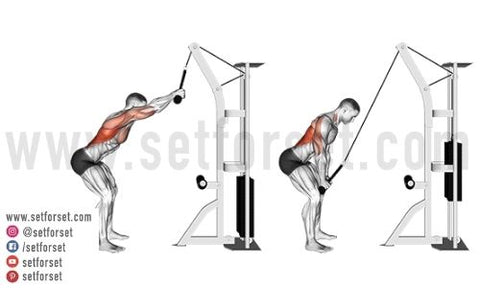
The straight arm lat pulldown exercise provides a deep stretch within the lats and shoulders, which is why it makes the list of best cable back exercises. It not only works your back and shoulders but in addition engages your chest and the long head of the triceps.
Don’t go too heavy on this one to start out, all too often people attempt to lift an excessive amount of weight here and find yourself with bad form when their back rounds they usually are only using arms and shoulders to pushdown.
That is certainly one of our favourite exercises to focus on the lower lats.
do the Standing Cable Lat Pulldown:
- Attach rope or bar above head level
- Step back so which you could lean forward barely to achieve up with prolonged arms and grab rope with a neutral grip (bar with overhand grip)
- Brace your core while flattening along with your arms straight until your hands reach thigh level
- Briefly pause then slowly return to starting position
- Repeat desired reps
Note: Keep your elbows locked throughout the movement.
Muscles Worked in Standing Cable Lat Pulldown: Lats, Teres Minor, Rear Delts, Triceps, Pecs
7 Advantages Of Doing Back Cable Exercises
There are many advantages of performing a cable exercise for back. Take a look at some more advantages of cable back exercises below.
1) Builds Strength & Muscle:
If done right and with intensity back exercises with a cable machine can generate some serious muscle strength and size gains. There’s a reason why every serious gym on the planet has cable machines; they work.
Great for hypertrophy rep ranges of 6-20, the cable machines mean you can squeeze out that last rep or two that’s needed to stimulate muscle growth.
2) Suited to All Fitness Levels:
Each advanced lifters and novices can get plenty of out doing back exercises with a cable. Advanced lifters might need to goal a selected smaller supporting muscle comparable to the teres major/minor or the infraspinatus.
Beginner lifters can use the cable machine to do back exercises because the cable helps to maintain movements consistent in the precise range of motion compared with free weights which are less forgiving. Also, some cable machines might even have pictures or labels with an outline of how one can do the exercise. Take our full body machine workout plan, for instance.
3) Helps Maintain Proper Form:
An excellent cable back exercise can assist prevent injuries by aiding in ensuring proper lifting technique and form. When using barbells or dumbbells form is paramount because you might have to manage the load the whole time.
Back exercises with a cable machine will provide help to move through a full range of motion without vying off the intentional path.
4) Controlled Range of Motion:
One primary difference between doing back exercises with free weights and a cable machine is that you simply’re in a position to change up angles and positions.
Gravity is at all times fighting against free weight whereas cable machines make it possible to approach the identical exercise at a special angle comparable to lat rows which you may do by flattening from the load above or at an angle like in bent over rows. Cable back exercises may be done easier without jerky movements.
5) Constant Tension on Muscles:
Cable pulley machines apply constant tension in your muscles. You should have to work on each side of a movement i.e lat pulldowns you engage your back and arm muscles to drag the load down but you furthermore mght activate the muscles by controlling the load on the best way back up.
This results in increased time under tension, which is a obligatory component of constructing strong lean muscles.
6) Extremely Versatile:
You’ll be able to move your arms in lots of directions when using the cable machine to do back exercises, this implies you may goal the muscles from multiple angles easily.
You too can switch up your grip of the attachment on the cable machine with ease to perform a mess of exercises effectively and safely.
7) Great for Isolation:
The mixture using the cable machine with multiple attachments, body positions, angles, and other equipment like a workout bench makes it easy to isolate specific muscles compared with free weights.
This is vital when doing back exercises because people often have trouble with targeting muscles just like the teres major/minor or the rhomboids.
Back Muscle Anatomy
We won’t go into depth here on the anatomy and performance of those back muscle groups as there are so much.
Nonetheless, it is crucial we not less than gloss over among the larger superficial muscles in your back that these cable back exercises will hit starting on the upper back and dealing our way down. It is also essential to notice that your rotator cuff muscles are hard at work for plenty of these exercises.
1) Trapezius:
A.K.A the traps, this triangular broad-shaped muscle stretches from the occipital bone (base of skull) to the lower thoracic vertebrae to the scapula. The fundamental function of this muscle group is to support the arm and move the scapula.
One of the crucial noticeable and distinguished muscles of the back; for those who need a good-looking, strong back you have to construct these bad boys.
2) Rhomboids:
Getting its name from the rhombus (quadrilateral shape) the rhomboids are comprised of two muscles; the rhomboid major and minor. The fundamental function of the rhomboids is to assist within the movement of the scapula.
Positioned under the traps they stretch from the spine to the medial region of the scapula. This muscle doesn’t get plenty of love so it’s essential that you simply deal with targeting this muscle using various back exercises and angles found below.
3) Teres Major:
The larger of the teres muscles, the teres major attaches to the scapula and the humerus and is positioned above the latissimus dorsi.
The fundamental function of the teres major is to help within the extension and medial rotation of the humerus. Constructing a robust teres major will add to the highest a part of the coveted “V” shaped back.
4) Teres Minor:
The opposite smaller teres muscle, this narrow-rounded muscle is a component of the rotator cuff. It starts on the scapula and inserts into the humerus and the joint capsule.
The fundamental function is to manage the deltoid motion and stop the humeral head from moving upward when the arm is abducted.
5) Latissimus Dorsi:
The latissimus dorsi is the biggest and widest muscle within the back and the biggest muscle in the whole upper body. Also called the “lats” this muscle wraps around our back from our sides to our midback where it’s partly covered by the trapezius.
The fundamental function of the lats is extension, adduction, horizontal abduction, medial rotation of the shoulder joint, flexion from an prolonged position and more.
6) Erector Spinae:
Ranging from your lower spine stretching as much as your neck. This muscle is accountable for straightening and rotating the spine. The corner stone of your lower back, a robust erector spinae is obligatory to maintain our body performing at its best.

Sample Cable Back Workout
As you saw above many exercises engage each primary and secondary muscles so with a view to construct an all-around strong back we’ll have to hit all areas.
Ranging from the lower back you may do exercises like cable deadlifts or cable pull throughs to strengthen the posterior chain. For mid-back, deal with exercises where your hands are closer together like close grip rows. For the upper back select exercises like wide grip rows, single-arm bent over rows and cable shrugs.
Lastly, remember to combine in not less than certainly one of the cable back exercises with transverse plane motion like standing row with twist.
You’ll be able to follow the sample back workout using a cable machine or you may mix and match a couple of of the cable back exercises above to create your individual cable back workouts.
Whatever you choose to do in relation to your back workouts with cables, be sure you are attempting to hit all major muscles of the back.
Back Workout With Cables:
| Cable Lat Pulldown | 3 sets x 8 reps |
| Cable Lying Pullover |
2 sets x 12 reps |
| Cable Deadlift |
3 sets x 6 reps |
| Seated Close Grip Row |
3 sets x 8-12 reps |
| Cable Shrug | 4 sets x 6 reps |
| Standing Cable Twist Row |
3 sets x 10 reps (either side) |
Note: Take 60-90 seconds rest between sets and as much as 2 mins between deadlift sets. This cable back workout should take around 60 mins assuming you are proper warmed up with some dynamic stretches.
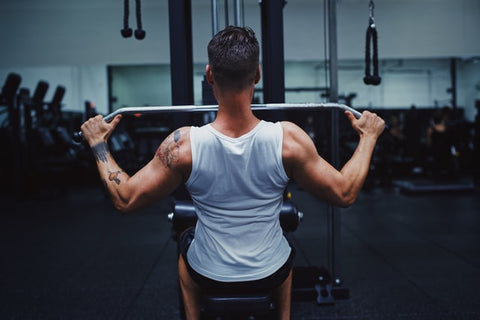
Best Cable Back Exercises: Final Takeaways
We hope that we introduced you to some latest cable back exercises that you simply have not seen or tried before. The 21 best back exercises with cables can support you in your journey of constructing a stronger, healthier back.
Remember to perform quite a lot of back exercises with the cables together with different attachments and from multiple angles. The identical holds true for cable exercises and free weights. Be sure you are doing the exercise with proper form and intensity. Now we’ll allow you to get back to it… see what we did there.






